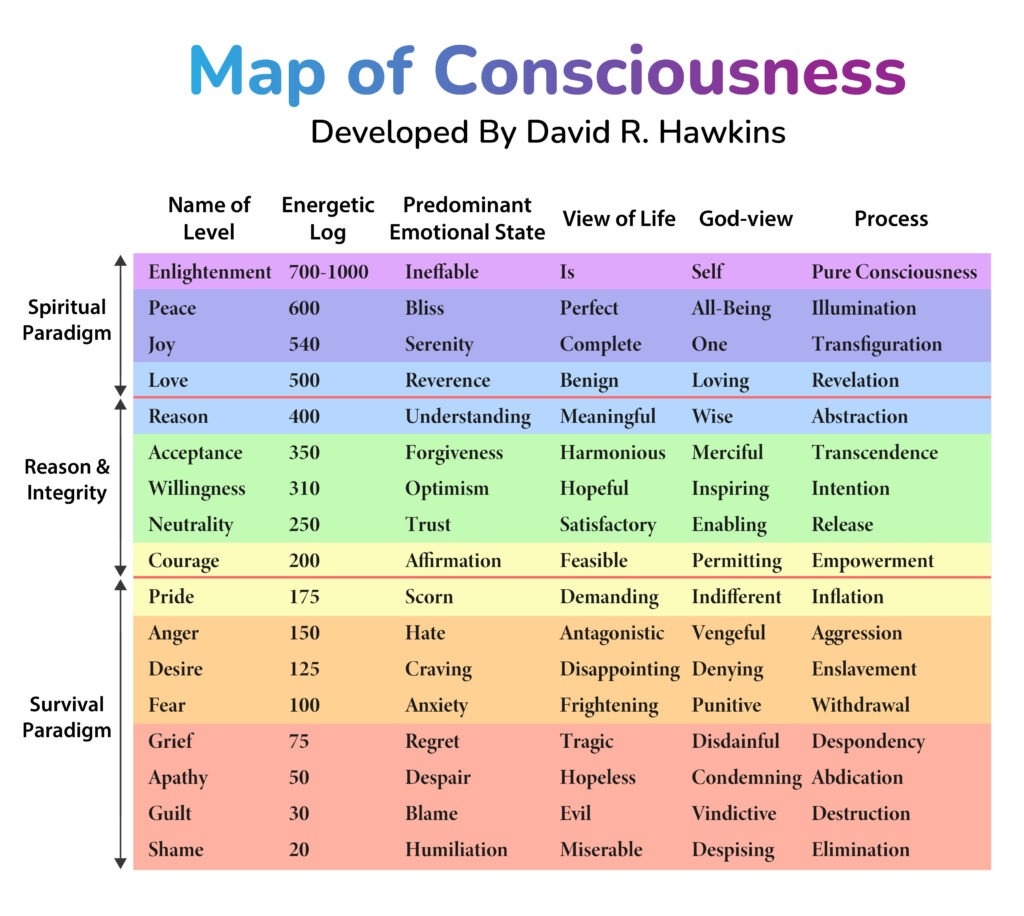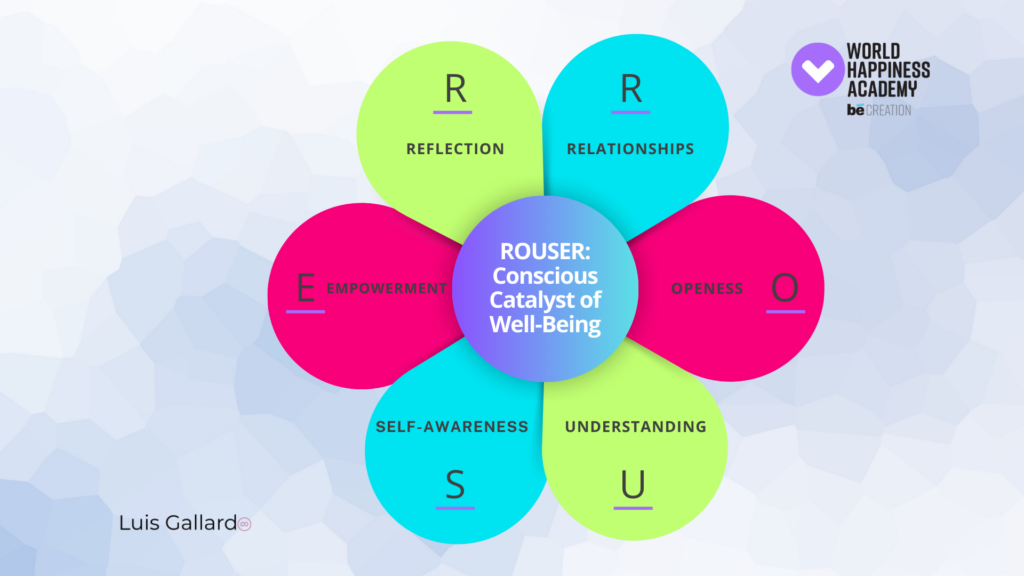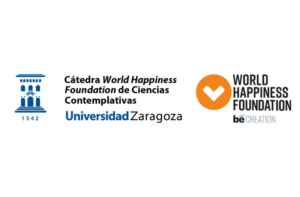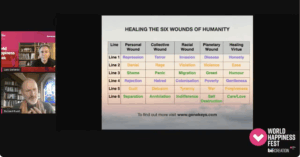
Happytalism and the 2025 Doha Political Declaration: A Paradigm Shift for Social Transformation
Executive Summary The Doha Political Declaration adopted at the 2025

Integrating Archetypal Roles, Hawkins’ Scale, and the ROUSER Model
Facilitators, consultants, and coaches often observe that teams function at different “levels of consciousness” – from disempowered and reactive groups to highly self-aware, purpose-driven ones. Multiple frameworks can shed light on these developmental stages. This guide will explore and integrate three such frameworks: (1) the four archetypal consciousness roles (Victim, Manifestor, Channel, Being), (2) David R. Hawkins’ Scale of Consciousness, and (3) the ROUSER leadership model by Luis Miguel Gallardo (Relations, Openness, Understanding, Self-Awareness, Empowerment, Reflection). We’ll outline each framework, show how they illuminate stages of growth in awareness, and map their relationships – for example, which ROUSER pillars align with higher states on Hawkins’ scale or help a team transition out of “victim” mode. Finally, we provide practical tools, diagnostic questions, and applications for assessing a team’s dominant level of consciousness and guiding it toward greater empowerment, self-awareness, and shared purpose.
One useful model (popularized by Michael Bernard Beckwith) describes four archetypal levels or roles of consciousness an individual (or group) can experience. These are sometimes summarized as “to me, by me, through me, as me,” indicating the perceived relationship between oneself and life. Each stage represents a shift in how we view personal power, responsibility, and connection:
Key point: These four archetypal roles aren’t strictly linear or permanent labels – individuals and groups can move fluidly among them. However, they provide a useful lens on development. In summary, one grows from Victim (powerless, low awareness) to Manifestor (empowered doer), then to Channel (trusting co-creator), and finally Being (unity consciousness). Each stage expands one’s capacity for responsibility, love, and wisdom.
Psychiatrist David R. Hawkins developed a Map of Consciousness that assigns numerical values to various levels of human awareness and emotion, from 0 up to 1000 (enlightenment). Each level on this logarithmic scale correlates with specific emotions, perceptions of life, and ways of being. Hawkins’ framework is often visualized as a ladder or spectrum – at the bottom are the most constrictive, painful states (shame, guilt), and at the top are the most expansive (peace, enlightenment). Importantly, any level above 200 on the scale is considered life-affirming or “power” (courage and upward), whereas levels below 200 denote life-negating or “force” (associated with suffering, blame, despair). Below is a selection of key levels from Hawkins’ scale:

It’s important to note that people (and groups) are not stuck at one level forever – our state can fluctuate. For example, a person might generally calibrate around Acceptance (350) but drop into Fear (100) during a sudden crisis. The scale is less about strict ranking and more about understanding the predominant vibration or mindset one operates from. Hawkins emphasizes that higher isn’t “better” in a moral sense; each level is simply a different expression of consciousness, much like water can be ice, liquid, or vapor depending on temperature. As consciousness “warms up,” it flows more freely and eventually becomes expansive (an apt metaphor: below 32°F water is solid ice, like a rigid low-consciousness mindset; at moderate temperatures it flows; above 212°F it vaporizes into a vast, formless state, analogous to enlightenment). The journey of development typically involves moving upward through courage into the “power” levels, increasing one’s capacity for love, joy, and peace. With that growth comes greater effectiveness, creativity, and wisdom – for instance, at the level of Courage and above, people feel empowered and confident, and at Reason and Love, they access higher creativity, intuition, and compassion.
While the first two frameworks come from spirituality and psychology, the ROUSER model by Luis Miguel Gallardo is a leadership-centric framework. ROUSER is an acronym for six pillars of conscious leadership and team culture: Relations, Openness, Understanding, Self-Awareness, Empowerment, and Reflection. It was designed to develop “conscious catalysts of well-being” in organizations. Each pillar represents a key dimension of higher organizational consciousness and effective leadership:

In summary, the ROUSER model provides a practical checklist for conscious leadership behaviors. A team or leader embodying all six pillars would likely operate at a high level of consciousness: they build trust (Relations), remain transparent and adaptable (Openness), practice empathy (Understanding), have emotional intelligence (Self-Awareness), uplift and unleash others’ potential (Empowerment), and continually learn and realign (Reflection). Gallardo’s work suggests that integrating these principles creates resilient, innovative, and thriving cultures. Notably, these pillars resonate strongly with other conscious leadership principles (for example, many experts emphasize self-awareness, empathy, and integrity as keys to conscious leadership). In essence, ROUSER offers a roadmap to move an organization from a reactive, low-consciousness state toward one of empowerment, engagement, and well-being.
Each of the three frameworks above looks at human development and consciousness through a different lens, yet they complement each other. By comparing them, we can see clear parallels. Beckwith’s four levels describe shifts in how we relate to life (from powerless to oneness). Hawkins’ scale gives a detailed spectrum of emotional-energy states from lowest to highest. ROUSER’s pillars identify qualities and practices in organizations that correspond to more conscious leadership. How do these line up? Consider the following alignment between the models:
Victim consciousness (Stage 1 “to me”) correlates with the lowest ranges on Hawkins’ scale and an absence of most ROUSER qualities. A victim-oriented individual or team often resonates around emotions like fear (100) or apathy (50) on the scale – life feels overwhelming or unfair. In this state, Empowerment and Self-Awareness (ROUSER pillars) are minimal: the group doesn’t yet take responsibility or see its own part in problems. Typically, Openness is also low (victim mentality tends to be closed and defensive, stuck in “nothing can be done”). Relationships may be characterized by blame or dependence rather than trust – so the Relations pillar is weak or is one of unhealthy codependency. Moving out of victimhood requires igniting Empowerment and Self-Awareness in particular, which correspond to rising above the Courage level (200) on Hawkins’ scale. For example, once a person finds the courage to say “I can change this” instead of “I can’t help it,” they are stepping into empowerment and leaving victim consciousness. In Hawkins’ terms, this is the leap from life-view “Hopeless/tragic” at very low levels to at least “Feasible” or “Hopeful” around 200 (Courage) and 250 (Neutrality). At that turning point, a team starts focusing on what can be controlled or improved rather than what’s being done to them. Leaders can facilitate this by introducing accountability and solution-oriented conversation (we’ll discuss tools shortly).
Manifestor consciousness (Stage 2 “by me/for me”) aligns with mid-range levels on Hawkins’ map – roughly the Courage to Reason band (200–400), where positive energy, ambition and intellect come online. At Manifestor, the group is empowered: they believe “Life is happening for us; we can achieve our goals if we work for them.” This corresponds emotionally to confidence, willingness, and a drive for improvement (Hawkins’ levels of Willingness 310, Acceptance 350, up to maybe Pride 175 and Reason 400 as a cap if ego stays strongly involved). In this stage, ROUSER pillars like Empowerment and Self-Awareness become much stronger – individuals take ownership and are aware of their influence. Relations may start to improve because people see others as collaborators rather than threats. However, at the early Manifestor stage there may be less Understanding or Openness if the focus is still “I will make it happen” (which can be somewhat ego-centric). The team might be highly driven and “can-do” but might need more empathy and openness to further evolve. The Manifestor phase is productive and accountable, but to progress, the group should cultivate humility and openness – recognizing that not everything is under personal control and that collective or higher wisdom can play a role. This sets the stage for Stage 3.
Channel/Vessel consciousness (Stage 3 “through me”) connects with higher levels on Hawkins’ scale, typically Love (500) and above, or at least solidly in the positive range beyond mere intellect. This is where surrender, trust, and genuine care emerge – emotions like love, joy, and peace become more common. A team in Channel consciousness often operates with Acceptance (350) and Love (500) as dominant vibes: there is empathy, big-picture thinking, and a sense of service. It’s no surprise that at this stage, ROUSER pillars such as Openness, Understanding, and Reflection really flourish. Openness – the willingness to let go of rigid control and welcome new ideas – is essential to “let life flow through.” Understanding – empathy – becomes a guiding principle, as the team recognizes a larger interconnected purpose (“we let a higher purpose work through us”). Reflection deepens because individuals and teams regularly step back to listen to their intuition or a “higher voice” and learn from experience. Self-Awareness continues to deepen as well, often through mindfulness or spiritual practices that accompany this surrendering mindset. The Empowerment pillar in Stage 3 takes on a new flavor: it’s less about ego empowerment (“I have power”) and more about collective or inner empowerment (“We are empowered by something greater when we align with it”). On Hawkins’ scale, this stage might calibrate in the 500s, where one’s orientation is profoundly empathetic and life is viewed benignly or as loving. Essentially, the team transitions from “we are doing this” to “we are instruments of a larger mission”. Creativity and synchronicity tend to increase at this level – solutions seem to “appear” as the group stays open and aligned.
Being consciousness (Stage 4 “as me”) corresponds to the highest consciousness levels (600+ Peace, toward Enlightenment), albeit sustained experiences of this are rare. In this state, a team or individual experiences unity, non-duality, and present-moment awareness. On Hawkins’ map, that’s in the realm of Peace (600) and even Enlightenment (700–1000). A person here radiates calm and compassion; a team here operates with harmony and shared purpose at an almost spiritual level. All ROUSER pillars are fully realized in this stage. For instance, Relations are characterized by deep trust and unconditional respect – a sense of oneness among the members. Openness is total – truth is welcomed from wherever it arises; there’s no fear of vulnerability. Understanding is profound – people intuit each other’s needs and work in sync (sometimes described as a “collective consciousness” in high-performing, mission-driven teams). Self-Awareness is very high not just at the individual level but group self-awareness – the team is aware of its own dynamics and maintains integrity and authenticity effortlessly. Empowerment is a given – everyone is empowered because there’s no ego contest; roles become fluid and everyone leads as needed. And Reflection is second nature – continuous learning and presence are part of the team’s culture (perhaps through meditation sessions, deep dialogue, or simply a very mindful way of working). This Being stage in a group might be observed in highly evolved organizations or communities with a spiritual core, where the purpose is paramount and personal agendas are minimal. The life-view at this level, according to Hawkins, is one of complete unity and perfection – every experience is seen as an expression of the whole, and so there is constant peace and an enlightened perspective. While living 100% in this state is extraordinary, even glimpses of it can dramatically uplift a team’s creativity, effectiveness, and joy.
To visualize these correspondences, the table below aligns the three frameworks: the four archetypal roles, Hawkins’ approximate level range, and relevant ROUSER pillars or qualities at each stage. (Note that these are generalized correlations – real life is more fluid – but it captures the essence of each stage and how they relate.)
| Beckwith’s Consciousness Stage | Hawkins’ Scale (Key Levels & Emotions) | Corresponding ROUSER Pillars / Leadership Focus |
| Victim – “Life happens to me.” (Powerless, blame, separation) | Lowest levels (Below ~200) – Shame, Guilt, Apathy, Fear dominate. Life viewed as unsafe or hopeless; little trust or hope. | Lacking Empowerment & Self-Awareness. Low openness and understanding. Needs focus on Self-Awareness (recognizing own patterns) and Empowerment (taking responsibility) to rise out of victimhood. Relations are weak (blame or isolation). Leadership task: instill accountability, hope, and an internal locus of control. |
| Manifestor – “Life happens by me/for me.” (Personal power, will, ambition) | Mid levels (200–400) – Courage (200) through Reason (400). Marked by confidence, will, and intellectual achievement. Life seen as input-output: “I can make it happen.” | Strong Empowerment and Initiative. Growing Openness (to try new approaches) and Self-Awareness (learning strengths/weaknesses). Relations often transaction-based but improving with teamwork. Understanding may still be limited (focus on goals over feelings). Leadership focus: channel the high drive into collaboration, encourage empathy and humility (to prepare for next stage). Celebrate wins and personal growth, while introducing vulnerability as a strength. |
| Channel (Vessel) – “Life happens through me.” (Collaboration, surrender, purpose) | Higher levels (500+) – Love (500), Joy (540), approaching Peace (600). Marked by compassion, flow, and alignment with a higher cause. Life seen as guided and interconnected. | High Openness and Understanding. Team/leader emphasizes Relationships (trust, synergy) and acts with Empathy and shared purpose. Reflection and mindfulness guide decisions. Self-Awareness deepens (less ego, more spirit-led). Empowerment becomes collective (everyone feels valued and capable through the higher mission). Leadership task: nurture this culture – protect transparency, encourage intuition, reinforce the shared vision. Support individuals in “letting go” of control and trusting the team’s process. |
| Being (Oneness) – “Life happens as me.” (Unity, wholeness, enlightenment) | Highest levels (600–1000) – Peace (600) to Enlightenment. Marked by serenity, oneness, genius-level creativity, and profound peace. Non-dual awareness (no separation between “me” and “life”). | All ROUSER pillars fully embodied. Relations are unified (a true team-of-one mindset). Total Openness and authenticity; radical Understanding/compassion; deep Self-Awareness (and group awareness); natural Empowerment (each person leads self and others responsibly); constant Reflection (wisdom in action). Leadership in this stage is often facilitative/servant leadership – egoless, purely guided by vision and love. The team operates with self-governance and profound trust. The focus is on sustaining alignment with purpose and mentoring others. |
Looking at the table, we see how the ROUSER pillars can be mapped onto the journey up the consciousness scale. For example, Empowerment is the key to moving out of Victim (replacing “I can’t” with “We can!”), and it solidifies in the Manifestor stage. Self-Awareness begins to develop at that shift as well – without self-honesty, one stays in blame. Openness and Understanding become crucial as one transitions from Manifestor to Channel, because to surrender and work through a higher purpose, you must be open to new ideas and empathetic to others. By the time a team reaches the Channel stage, the leader’s role is very much about Relationships and Reflection – maintaining trust, facilitating learning, and keeping everyone connected to the mission (the “through me” source). At the pinnacle, Being, the distinction between the pillars blurs – a highly conscious team naturally practices all of them, as they are interrelated facets of a singular enlightened culture.
It’s also insightful to note that each framework uses different language but they point to similar shifts. Victim vs. Leader (in a group context) is a known dichotomy: effective leaders help teams leave the Victim mindset and take ownership. Hawkins’ scale provides nuance here: a team stuck in victimhood might calibrate around Fear (100), frequently expressing anxiety and helplessness, whereas a team that has shifted to accountability might calibrate around Courage (200) or higher, expressing determination and optimism. Meanwhile, ROUSER’s Empowerment pillar directly addresses this shift: it’s about focusing on what we can control and do, rather than what’s done to us. As another example, Beckwith’s Channel stage (“through me”) is essentially about trust, empathy, and letting go of ego – which we see reflected by Hawkins’ Love (500) level and ROUSER’s pillars of Understanding, Openness, and Reflection. All three frameworks, therefore, reinforce each other. They describe a path from contraction to expansion, from ego-centric to soul-centric, from unconscious reacting to conscious creating/being.
Understanding these models is illuminating, but the real value comes from applying them. This section offers practical tools, diagnostic questions, and techniques to help you assess a team’s current level of consciousness and foster its growth toward greater empowerment, awareness, and purpose. Use these ideas as a guide or toolbox when working with teams and communities:
To tailor your approach, first gauge where the group primarily “resides” on the consciousness spectrum. Here are some diagnostic questions and observations to help identify a team’s dominant mindset:
These questions will give you a qualitative sense of the team’s dominant level. You can also use surveys or self-assessment tools based on these frameworks. For instance, you might adapt Hawkins’ scale into a questionnaire where team members rate statements like “I feel our team is primarily driven by fear/courage/love/etc.” Or present Beckwith’s four stages and ask, “Which statement feels most true about how our team sees the world: ‘Life happens to us, by us, through us, or as us?’” Such reflective diagnostics not only inform you, but also spur the team’s own awareness of where they stand. Remember to approach assessment without judgment – emphasize that no level is “bad” or “good”, just different, and that awareness of the current state is the first step to growth.
After assessing, the next step is to identify growth opportunities and design interventions that will elevate the team’s consciousness – specifically moving them toward greater empowerment, self-awareness, and purpose (as the question highlights). Here are several practical strategies and tools to support that journey:
In implementing interventions, meet the team where they are. If a team is deeply in Victim mode, start small: you might first just get agreement to stop gossiping and start focusing on solutions (basic empowerment step). If a team is in Manifestor high-achiever mode but lacking heart, you might introduce empathy and purpose exercises to gently open them up. And if a team is already quite evolved (Channeling well), you might concentrate on sustaining that by deeper reflection and ensuring new members are onboarded into the high-conscious norms.
It’s also crucial to role-model these behaviors as a facilitator or leader. Demonstrate your own self-awareness by admitting mistakes; show openness by welcoming feedback on your facilitation; practice empathy by actively listening to the team’s concerns. When you embody the level of consciousness you’re trying to cultivate, you become a living example – and consciousness is contagious. As the team experiences a more empowered, aware, and purposeful way of working, they will likely find it more fulfilling and effective than old habits. This positive reinforcement creates a virtuous cycle: higher consciousness leads to better outcomes (e.g. more trust, creativity, and success), which then validates and motivates maintaining those higher practices.
Lastly, be patient and celebrate incremental progress. Moving up the levels is a gradual process with occasional slips. Acknowledge the shifts you see (“I noticed we didn’t blame anyone during that post-mortem, that’s a big improvement in our culture!”). Each step – from a team member taking ownership for the first time, to someone showing genuine empathy to a colleague, to the group rallying around a inspiring vision – is cause for recognition. These are signs of consciousness evolving. Over time, with continued practice, a team can transform from a fragmented, low-morale group into a cohesive, self-aware, and purpose-driven community. In other words, they move from merely reacting to life toward consciously creating a brighter reality together – embodying the very principles of Victim-to-Being, Fear-to-Love, and ROUSER leadership that we’ve explored.
Elevating the consciousness of individuals, teams, and communities is complex, but immensely rewarding work. By using frameworks like Beckwith’s four stages, Hawkins’ scale, and the ROUSER model in tandem, we gain a multi-faceted understanding of where a group is and how it can grow. The four archetypal roles remind us that teams can evolve from feeling powerless to living their purpose. Hawkins’ Map offers a nuanced picture of the emotional-energy shifts involved in that evolution. The ROUSER pillars translate these abstract levels into concrete leadership practices and cultural traits. Together, they show that moving toward empowerment, self-awareness, and purpose is not only possible but measurable and manageable. As a facilitator or coach, you now have a comparative lens to diagnose the current state and a collection of tools to nurture the next level. By assessing language and behaviors, you can pinpoint victim vs. creator dynamics. By implementing targeted interventions – from encouraging accountability and reflection to fostering empathy and aligning on purpose – you can gently guide the team upward. Every question that prompts introspection, every exercise that builds trust, every acknowledgement of personal agency is a step on the staircase of consciousness. Over time, these steps lead to teams that are not just high-performing in the traditional sense, but deeply conscious: resilient in adversity, creative in problem-solving, compassionate in culture, and united by a meaningful vision. This guide has provided a roadmap and techniques for that journey. The invitation now is to apply them, experiment with empathy and openness, and watch consciousness rise. In doing so, you’ll facilitate not just better teams, but a better world – one aware and empowered group at a time.
Sources: The concepts and strategies in this guide draw on multiple sources and thought leaders in consciousness and leadership. Key references include Michael Beckwith’s stages of spiritual development, David R. Hawkins’ Map of Consciousness for emotional levels, and Luis Gallardo’s ROUSER leadership model for well-being and transformative leadership. Additional research on victim mentality and empowerment, as well as conscious leadership practices, has informed the practical applications. These integrated insights offer a comprehensive approach to understanding and raising the consciousness of teams and communities.
With joy, Luis Miguel Gallardo Author of The Meta Pets Method | PhD Scholar| Professor of Practice Yogananda School of Spirituality and Happiness | Founder, World Happiness Foundation | Author, Unlocking the Hidden Light
#ShooliniUniversity #PhDJourney #ProfessorOfPractice #Hypnotherapy #EasternWisdom #WesternScience #SpiritualPsychology #ShivDhar #SoulfulLeadership #NatureHeals #YoganandaSchool #Himalayas #NonDuality #MetaPets #UnlockingTheHiddenLight
Explore the future of leadership:
Join our Alchemy of Leadership Program: https://www.worldhappinessacademy.org/offers/ezL8GGWJ
Join our community of Global Well-Being and Impact Leaders:
Apply here: Global Well-Being and Impact Leadership Certification – Application Page
Join us in this bold journey. Let’s champion a new paradigm of leadership together – one where happiness, well-being, and impact are at the heart of every strategy and every action.
Become a part of GWILC and help realize the vision of a world where everyone, everywhere can thrive in freedom, consciousness, and happiness. The next seven years of global leadership evolution start now – and we invite you to lead the way.
#LeadWithWellBeing #GWILC #Happytalism #GlobalLeadership #WorldHappiness
Join the Chief Well-Being Officer Program: https://www.worldhappinessacademy.org/english-chief-well-being-officer
….join the Cities of Happiness Initiative: https://www.teohlab.com/city-of-happiness
Unlocking the Hidden Light book: https://a.co/d/gaYuQJ6
Join the pull of Mental Health Professionals ready to help addressing trauma and nurturing collective well-being: https://forms.gle/39bGqU177yWcyhSUA
Join the community of catalysts of positive transformation: https://www.worldhappiness.academy/bundles/certified-chief-well-being-officer-professional-coach
Enjoy a free 30-minute coaching session with me. Book it here: https://www.worldhappiness.academy/courses/coaching-and-hypnotherapy-with-luis-gallardo
Link to Meta Pets Coloring Book
For more information and to join the movement, visit World Happiness Foundation.
#WorldHappinessFest #Happytalism #GlobalHappiness #WellBeing #Sustainability #ConsciousLiving #WorldHappinessFoundation #FreedomAndHappiness #GlobalWellBeing
Jaipur Rugs Jaipur Rugs Foundation Upasana Design Studio World Happiness Fest – bēCREATION World Happiness Academy University for Peace (UPEACE) – UN Mandated UPEACE Centre for Executive Education Saamdu Chetri Manas Kumar Mandal Dr. Rekhi Singh REKHI FOUNDATION FOR HAPPINESS Adamas University Shoolini University Saamdu Chetri Vibha Tara Manas Kumar Mandal Prof. (Dr.) Shauli Mukherjee Paulina Nava Villazon Michelle Taminato

Executive Summary The Doha Political Declaration adopted at the 2025

Introduction: Science and Spiritual Wisdom United for Peace Every year

Humanity carries deep core wounds that have shaped our personal